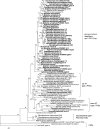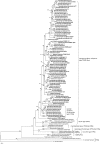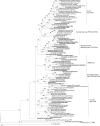Widespread occurrence and genomic context of unusually small polyketide synthase genes in microbial consortia associated with marine sponges
- PMID: 17293531
- PMCID: PMC1855645
- DOI: 10.1128/AEM.02260-06
Widespread occurrence and genomic context of unusually small polyketide synthase genes in microbial consortia associated with marine sponges
Abstract
Numerous marine sponges harbor enormous amounts of as-yet-uncultivated bacteria in their tissues. There is increasing evidence that these symbionts play an important role in the synthesis of protective metabolites, many of which are of great pharmacological interest. In this study, genes for the biosynthesis of polyketides, one of the most important classes of bioactive natural products, were systematically investigated in 20 demosponge species from different oceans. Unexpectedly, the sponge metagenomes were dominated by a ubiquitously present, evolutionarily distinct, and highly sponge-specific group of polyketide synthases (PKSs). Open reading frames resembling animal fatty acid genes were found on three corresponding DNA regions isolated from the metagenomes of Theonella swinhoei and Aplysina aerophoba. Their architecture suggests that methyl-branched fatty acids are the metabolic product. According to a phylogenetic analysis of housekeeping genes, at least one of the PKSs belongs to a bacterium of the Deinococcus-Thermus phylum. The results provide new insights into the chemistry of sponge symbionts and allow inference of a detailed phylogeny of the diverse functional PKS types present in sponge metagenomes. Based on these qualitative and quantitative data, we propose a significantly simplified strategy for the targeted isolation of biomedically relevant PKS genes from complex sponge-symbiont associations.
Figures





References
-
- Ahlert, J., E. Shepard, N. Lomovskaya, E. Zazopoulos, A. Staffa, B. O. Bachmann, K. X. Huang, L. Fonstein, A. Czisny, R. E. Whitwam, C. M. Farnet, and J. S. Thorson. 2002. The calicheamicin gene cluster and its iterative type I enediyne PKS. Science 297:1173-1176. - PubMed
-
- Azad, A. K., T. D. Sirakova, N. D. Fernandes, and P. E. Kolattukudy. 1997. Gene knockout reveals a novel gene cluster for the synthesis of a class of cell wall lipids unique to pathogenic mycobacteria. J. Biol. Chem. 272:16741-16745. - PubMed
-
- Boucher, Y., C. J. Douady, R. T. Papke, D. A. Walsh, M. E. R. Boudreau, C. L. Nesbo, R. J. Case, and W. F. Doolittle. 2003. Lateral gene transfer and the origins of prokaryotic groups. Annu. Rev. Genet. 37:283-328. - PubMed
-
- Campbell, E. L., M. F. Cohen, and J. C. Meeks. 1997. A polyketide-synthase-like gene is involved in the synthesis of heterocyst glycolipids in Nostoc punctiforme strain ATCC 29133. Arch. Microbiol. 167:251-258. - PubMed
-
- Dobrindt, U., B. Hochhut, U. Hentschel, and J. Hacker. 2004. Genomic islands in pathogenic and environmental microorganisms. Nat. Rev. Microbiol. 2:414-424. - PubMed
Publication types
MeSH terms
Substances
LinkOut - more resources
Full Text Sources
Other Literature Sources
Molecular Biology Databases
Miscellaneous

